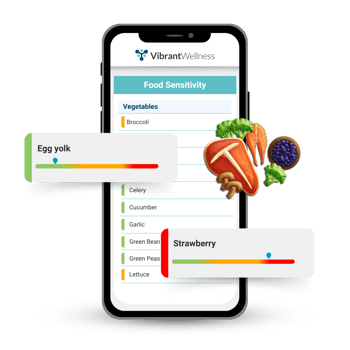Food Sensitivities vs. Allergies: Understanding the Difference with Advanced Testing
Many patients struggle with chronic symptoms like bloating, fatigue, and migraines but don’t get clear answers from standard allergy tests. As a health professional, it’s essential to have tools that go beyond basic testing to uncover hidden food reactions that may be impacting your clients’ health.
These often-overlooked sensitivities are a significant factor in various chronic health conditions. That’s where advanced testing, such as the Vibrant Food Sensitivity Panel, comes into play. This test helps identify food sensitivities that traditional methods typically miss, enabling you to create targeted and effective protocols for your clients.
Table of Contents
Understanding Food Reactions: Key Differences
Food-related reactions can generally be categorized into three primary types: food allergies, food intolerances, and food sensitivities. Each type has dFooifferent causes, mechanisms, and symptoms that can significantly affect a person’s health, though they are often confused with one another. Understanding these differences is vital for properly diagnosing and addressing the issues.
Food Allergies
Food allergies involve an immediate immune response triggered by the presence of certain food proteins. These immune responses are typically mediated by Immunoglobulin E (IgE), which activates allergic reactions in the body. Symptoms of food allergies can be immediate and severe, including hives, swelling, difficulty breathing, or even anaphylaxis, which can be life-threatening. Common food allergens include peanuts, shellfish, and dairy (Sampson et al., 2006). According to a study published by the American Medical Association, IgE-mediated food allergies can lead to systemic anaphylaxis, a potentially fatal reaction that requires immediate medical intervention (Sampson, 2006).
Food Intolerances

Food intolerances occur when the body lacks the necessary enzymes to break down certain food components. For instance, lactose intolerance happens when there is a deficiency in lactase, the enzyme responsible for digesting lactose, a sugar found in dairy products. Symptoms of food intolerances include bloating, gas, and diarrhea. These reactions are typically not immune-mediated but are instead linked to digestive issues (Shaheen et al., 2018). While food intolerances can be uncomfortable, they are rarely as dangerous as food allergies. Studies have shown that while intolerances are common, they usually do not lead to the life-threatening risks that food allergies do (Savaiano, 2015).
Food Sensitivities
Food sensitivities are delayed immune responses, often mediated by Immunoglobulin G (IgG) and Immunoglobulin A (IgA). Unlike food allergies, which trigger immediate symptoms, food sensitivities can take hours or even days to manifest, making them difficult to pinpoint. Symptoms of food sensitivities can include headaches, joint pain, digestive issues, fatigue, and skin rashes. Because these reactions are delayed, food sensitivities are harder to diagnose and require advanced testing to uncover (Vega et al., 2021).
Food allergies and intolerances are relatively easy to diagnose through standard methods, but food sensitivities require more specialized tools. Standard allergy tests typically do not detect these delayed immune responses, leaving many patients without answers for their ongoing symptoms. According to a study published in the Journal of Clinical Immunology, IgG and IgA-mediated food sensitivities contribute to chronic health conditions like migraines, joint pain, and gastrointestinal disturbances (Vega et al., 2021).
Why Standard Allergy Tests Aren’t Enough

Traditional allergy tests, such as skin prick tests or blood tests that measure IgE levels, are designed to detect immediate allergic reactions. These tests are excellent for diagnosing food allergies but fall short in identifying food sensitivities, which are mediated by IgG and IgA responses. As a result, patients may undergo standard allergy testing, only to still experience unexplained symptoms.
There are several reasons why standard allergy tests are not sufficient:
- Limited Scope: Standard tests focus solely on IgE-mediated reactions, missing IgG and IgA responses, which are key in food sensitivities (Vega et al., 2021).
- Delayed Reactions: Food sensitivities often lead to delayed symptoms that can take hours or days to appear, making them much harder to connect to specific foods without advanced testing (Gassull et al., 2020).
- Chronic Conditions: Sensitivities contribute to chronic health issues, including fatigue, joint pain, and digestive problems, which are not typically addressed by traditional allergy tests (Vega et al., 2021).
Without the proper tools to diagnose food sensitivities, wellness professionals may struggle to create effective diet plans that address the full range of food-related reactions in their patients.
Symptoms commonly associated with a need for detoxification support include:
- Gas
- Bloating
- Headaches or migraines
- Nausea
- Weight gain
- Brain fog
- Metallic taste in mouth
- Joint or muscle aches
- Inflammation
- Acne or rashes
- Fatigue
- Excess mucus
- Strong body odor
- Constipation
Since the body stores toxins in adipose tissue to protect vital organs, weight loss resistance may be another indicator of a high toxic burden. On the other end of the spectrum, rapid weight loss can release stored chemicals and toxins into the bloodstream more rapidly than they can be removed, leading to high toxic burden or neurological symptoms like headaches, thyroid issues, rashes, or asthma.

How the Vibrant Food Sensitivity Panel Helps
The Vibrant Food Sensitivity Complete is a powerful tool for identifying delayed food sensitivities that are often missed by traditional allergy tests. This advanced test detects both IgG and IgA reactions to over 209 foods and food peptides, using cutting-edge microarray technology for highly accurate and reliable results.
The Vibrant Food Sensitivity Complete panel stands out for several reasons:
- Comprehensive Food Coverage: The test screens for a wide range of foods, including common allergens and less commonly recognized food triggers, giving you a more complete picture of your patients’ sensitivities.
- Identifies Delayed Reactions: By detecting IgG and IgA responses, the test uncovers sensitivities that cause delayed immune responses, which traditional tests fail to identify.
- Guides Elimination Diets: The results from the Vibrant Food Sensitivity Panel make it easier to implement elimination diets, which can help pinpoint problem foods and track improvements over time.
By using the Vibrant Food Sensitivity Panel, you can uncover hidden food sensitivities and provide your patients with personalized care that addresses their specific needs.
Vibrant Wellness conducted a landmark clinical trial on food sensitivity diets. You can hear from the participants here.
Real-Life Success Stories

Real-life examples illustrate the effectiveness of food sensitivity testing:
Case 1: Chronic Digestive Issues
A 38-year-old woman presented with chronic bloating and IBS-like symptoms but tested negative for common food allergies. She had tried multiple elimination diets, but the relief was only partial. After using the Vibrant Food Sensitivity Complete panel, she was found to have elevated IgG levels to eggs and almonds—two foods she consumed daily. After eliminating these foods from her diet, her symptoms significantly improved within a few weeks.
Case 2: Fatigue and Brain Fog
A 45-year-old mom of two, struggled with persistent fatigue and brain fog despite multiple medical tests that yielded no clear answers. Advanced sensitivity testing revealed high IgA reactions to dairy and wheat. After eliminating these foods from his diet, she reported noticeable improvements in energy and mental clarity within a month.
How to Use Food Sensitivity Testing in Practice

To get the most out of food sensitivity testing, follow these steps:
- Create Targeted Elimination Diets: Based on the results of the test, remove the high-reactivity foods from your patients’ diets. This allows you to assess how these foods may be contributing to their symptoms.
- Monitor Symptom Changes: Monitor symptom changes over the course of 4-6 weeks to track improvements. This period allows the body to adjust to the removal of triggering foods and provides insight into which foods may be causing the issues.
- Reintroduce Foods Systematically: After the elimination phase, reintroduce eliminated foods one at a time. Observe any returning symptoms to confirm sensitivities. This process helps identify specific food triggers that need to be avoided in the future.
- Support Gut Health: Food sensitivities are often linked to gut imbalances, such as leaky gut. Pairing the Vibrant Food Sensitivity Panel with additional tests like the Vibrant Gut Zoomer can help uncover deeper digestive issues and optimize your patient’s treatment plan.
Understanding the differences between food allergies, intolerances, and sensitivities is key to helping your patients achieve better health. Standard allergy tests often don’t reveal the full picture, leaving many patients without answers to their chronic symptoms. Advanced testing tools like the Vibrant Food Sensitivity Panel provide deeper insights into delayed food reactions, allowing you to create more effective, personalized care plans for your patients.
If you want to eliminate the guesswork surrounding food sensitivities and give your patients the targeted care they deserve, consider exploring the Vibrant Food Sensitivity Complete panel. Start making a real difference in your practice today and help your patients unlock their path to better health.
About the Author
Melissa is a passionate Holistic Nutrition Coach dedicated to empowering individuals on their journey to true health. Her approach integrates functional medicine, nutrition science, and personalized mindwork to promote physical, mental, and emotional balance.
Specializing in addressing complex health challenges such as gut imbalances and chronic conditions, Melissa focuses on breaking down overwhelming obstacles into manageable, actionable steps.
For those with long-standing health and dietary concerns, her practice emphasizes the interconnectedness of mind, body, and spirit to foster healthier relationships with food and oneself, leading to profound, lasting transformations. By combining evidence-based interventions with cutting-edge diagnostics, Melissa crafts personalized strategies that empower clients to reclaim their health and vitality. Learn more about Melissa's practice here.
References:
- Sampson HA. Food allergies: pathogenesis and diagnosis. The Journal of Allergy and Clinical Immunology. 2006.
- Shaheen NJ, Hansen R, et al. Lactose intolerance in the United States: prevalence and effects on quality of life. The American Journal of Gastroenterology. 2018.
- Savaiano DA. Lactose intolerance: the influence of dairy products on the development of health problems. The American Journal of Clinical Nutrition. 2015.
- Vega J, Agusti A, et al. The role of food sensitivities in chronic health conditions: an overview. Journal of Clinical Immunology. 2021.
- Gassull MA, Ripoll C, et al. Food sensitivities and gastrointestinal symptoms: a review of current findings. Digestive Diseases and Sciences. 2020.
Regulatory Statement:
The information presented in case studies have been de-identified in accordance with the HIPAA Privacy protection.
The general wellness test intended uses relate to sustaining or offering general improvement to functions associated with a general state of health while making reference to diseases or conditions. This test has been laboratory developed and its performance characteristics determined by Vibrant America LLC and Vibrant Genomics, a CLIA-certified and CAP-accredited laboratory performing the test. The lab tests referenced have not been cleared or approved by the U.S. Food and Drug Administration (FDA). Although FDA does not currently clear or approve laboratory-developed tests in the U.S., certification of the laboratory is required under CLIA to ensure the quality and validity of the test
 By
By



